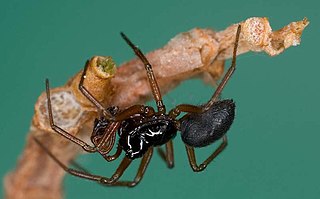
Ant spiders are members of the family Zodariidae. They are small to medium-sized eight-eyed spiders found in all tropical and subtropical regions of South America, Africa, Madagascar, Australia-New Guinea, New Zealand, Arabia and the Indian subcontinent. Most species are daytime hunters and live together with ants, mimicking their behavior and sometimes even their chemical traits. Although little is known about most zodariids, members of the genus Zodarion apparently feed only on ants; a number of other genera in the family are apparently also ant specialists.

Dictynidae is a family of cribellate, hackled band-producing spiders first described by Octavius Pickard-Cambridge in 1871. Most build irregular webs on or near the ground, creating a tangle of silken fibers among several branches or stems of one plant.
Tenedos is a spider genus of the family Zodariidae. It has around 72 species from Central and South America.
Colima is a genus of spiders in the family Zodariidae, found in the state of Colima, Mexico.

Coneweb spiders (Diguetidae) are six-eyed haplogyne spiders that live in tangled space webs, fashioning a cone-like central retreat where they hide and lay eggs. It is a small family, containing only two genera split between a range in the Southwestern United States and Mexico and a range in South America. Members of the genus Diguetia usually build their webs in shrubs or between cactus pads. They have the same eye arrangement as the venomous recluse spiders, but none are known to be harmful to humans.

Metepeira is a genus of orb-weaver spiders first described by F. O. Pickard-Cambridge in 1903. The name is derived from the Ancient Greek μετά and the obsolete genus name Epeira, denoting a genus similar to Epeira.

Erigone is a genus of dwarf spiders that was first described by Jean Victoire Audouin in 1826. They are carnivorous, preying on small insects such as Psylla and flies. One of the distinctive characters for this genus is the presence of teeth bordering the carapace.
Melpomene is a genus of funnel weavers first described by O. Pickard-Cambridge in 1898. They range from southwestern U.S. to Panama and can grow up to 7 to 8.5 millimetres long. Roth and Brame noted that, with many undescribed species, the genus appears to be a catchall or "wastebasket taxon" for several unrelated species that may represent several genera.

Agyneta is a genus of dwarf spiders that was first described by J. E. Hull in 1911.
Ceratinopsis is a genus of dwarf spiders that was first described by James Henry Emerton in 1882.

Emblyna is a genus of cribellate araneomorph spiders in the family Dictynidae, and was first described by R. V. Chamberlin in 1948.

Eustala is a genus of orb-weaver spiders first described by Eugène Simon in 1895.
Epicratinus is a genus of spiders in the family Zodariidae. It was first described in 2005 by Jocqué & Baert.
Phruronellus is a genus of North American araneomorph spiders first described by R. V. Chamberlin in 1921. Originally placed with the Liocranidae, it was moved to the Corinnidae in 2002, and to the Phrurolithidae in 2014.
Scotinella is a genus of North American araneomorph spiders in the family Phrurolithidae, first described by Nathan Banks in 1911.

Phrurolithus is a genus of araneomorph spiders first described by C. L. Koch in 1839. First placed with the Liocranidae, it was moved to the Corinnidae in 2002, then to the Phrurolithidae in 2014.

Xenoctenidae is a family of araneomorph spiders separated from Miturgidae in 2017.
Piabuna is a genus of North American araneomorph spiders first described by R. V. Chamberlin & Wilton Ivie in 1933. Originally added to the Liocranidae, it was moved to the Corinnidae in 2002, then to the Phrurolithidae in 2014.
Phonotimpus is a genus of North American araneomorph spiders in the family Phrurolithidae. It was first described by Willis J. Gertsch and Louie Irby Davis in 1940, and placed with the Liocranidae. It was transferred to Corinnidae in 2002, then to the Phrurolithidae in 2014.










